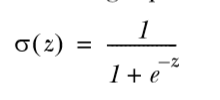Machine Learning–logistic regression
我们拿到一大堆数据,然后根据这一大堆数据我们得到一个等式,来为我们做分类。
什么是 logistic regression
更适合用来做分类的sigmoid函数:

在 0 处值为 0.5, 增大趋近于 1, 减小趋近于 0
如果输入值 z 表示为w0x0+w1x1+ ······ wnxn (因为我们输入的 x 往往是一个 vector)需要考虑找到一个 w,也就是一个系数矩阵,并且应当是最佳的。
一些 optimization algorithms
gradient ascent 与 stochastic gradient ascent
梯度:
这时梯度上升就可以写成:

α 是步长, 后面乘的则是梯度方向,这样一来就总是得到函数的最大值
注意梯度算法的终止条件是:走特定的步数,或者到达特定的范围
def gradAscent(dataMatIn, classLabels):
# dataMatrix 100 * 3, labelMat 1 * 100
dataMatrix = mat(dataMatIn)
# make labelMat to 100 * 1
labelMat = mat(classLabels).transpose()
m, n = shape(dataMatrix)
alpha = 0.001
# repeat times before stopping the calculation
maxCycles = 500
# start with all weights to 1, weights 3 * 1
weights = ones((n, 1))
for k in range(maxCycles):
# calculate the gradient of the whole dataset, and h is a 100 * 1 matrix
h = sigmoid(dataMatrix * weights)
# calculate the error between predicted classes and actual classes
error = (labelMat - h)
# move in the direction of the error
weights = weights + alpha * dataMatrix.transpose() * error
return weights
最终返回一堆权重
前面的算法都是直接拿很多(一般是一定量)数据来做 traing,叫做 batch processing
stochastic gradient ascent 是一次一次计算 weights 来不断变化 weights, 它是 online learning algorithm
def stocGradAscent0(dataMatrix, classLabels):
m, n = shape(dataMatrix)
alpha = 0.01
weights = ones((n))
for i in range(m):
h = sigmoid(sum(dataMatrix[i] * weights))
error = classLabels[i] - h
weights = weights + alpha * error * dataMatrix[i]
return weights
不同之处在于这里全部用的是 array,没有 matrix, 这样操作就是基于 array 元素的了,是一个一个的了,不是一批一批的了
Action
gradient ascent:

stochastic gradient ascent:

看起来 stochastic gradient ascent 并没有什么优势,这是因为它只循环了一次。
def stocGradAscent1(dataMatrix, classLabels, numInter=150):
m, n = shape(dataMatrix)
weights = ones((n))
for j in range(numInter):
dataIndex = range(m)
for i in range(m):
alpha = 4 / (1.0 + j + i) + 0.01
randIndex = int(random.uniform(0, len(dataIndex)))
h = sigmoid(sum(dataMatrix[randIndex] * weights))
error = classLabels[randIndex] - h
weights = weights + alpha * error * dataMatrix[randIndex]
del(dataIndex[randIndex])
return weights
修改后的 stocGradAscent 加上了随机和循环次数

这是修改后的图形,已经要比之前的很好的了
# get the value of sigmoid and decide which this is a 1 or 0
def classifyVector(inX, weights):
prob = sigmoid(sum(inX * weights))
if prob > 0.5: return 1.0
else: return 0.0
def colicTest():
frTrain = open('horseColicTraining.txt')
frTest = open('horseColicTest.txt')
trainingSet = []
trainingLabels = []
for line in frTrain.readlines():
# get each line
currLine = line.strip().split('\t')
lineArr = []
for i in range(21):
# get the list of lines
lineArr.append(float(currLine[i]))
trainingSet.append(lineArr)
# get the labels of the data
trainingLabels.append(float(currLine[21]))
trainWeights = stocGradAscent1(array(trainingSet), trainingLabels, 1000)
errorCount = 0;
numTestVec = 0.0
for line in frTest.readlines():
numTestVec += 1.0
currLine = line.strip().split('\t')
lineArr = []
for i in range(21):
lineArr.append(float(currLine[i]))
if int(classifyVector(array(lineArr), trainWeights)) != int(currLine[21]):
errorCount += 1
errorRate = (float(errorCount) / numTestVec)
print("the error rate of this test is: %f" % errorRate)
return errorRate
def multiTest():
numTest = 10
errorSum = 0.0
for k in range(numTest):
errorSum += colicTest()
print("after %d iterations the average error rate is : %f"%(numTest, errorSum/float(numTest)))
最终计算出错误率。
那么 logistic regression 基本上到这儿为止,其基本原理是计算出预测值与标准值之间的偏差,然后修改权重,决定移动的方向




















 1573
1573











 被折叠的 条评论
为什么被折叠?
被折叠的 条评论
为什么被折叠?








